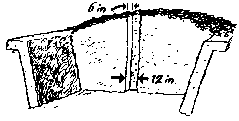|
For Reliable Feed and Forage Analysis Results
Feedstuffs are grown, harvested, and stored under a variety of conditions that dramatically affect quality. Differences in feedstuff quality and sampling procedures can cause fluctuations in feed analysis results. The procedures listed are common, recommended practices which aid in obtaining the most representative sample possible. A representative sample is the most important step in achieving accurate analysis.
Sampling Procedures
A defined sample lot helps in receiving an accurate sample. Separate feedstuffs to be sampled into “lots” using separate fields, cuttings, maturity at cutting, fertility history, mixer batch, and source of the feedstuff as criteria. Sample and analyze each lot separately.
Hay
Sample size required: at least quart (8x8) zip lock bag 3/4 full.
Square and round bales:
Select 12 to 15 typical bales from each lot. Using a hay probe, collect a subsample from each bale by coring into the end of square bales and into the circumference of round bales. Core in an upwards direction to reduce moisture spoilage. Place the subsample in a plastic bag, exclude excess air and seal tightly. Collecting sampling by hand is not recommended.
Hay Stacks:
 Select 4 to 5 stacks from each lot. Using a hay probe with a 24 inch barrel, collect 3 subsamples per stack. Collect the subsamples from the side of each selected stack as shown in this figure. The top sample should be taken two feet from the top edge of the stack and the bottom sample two feet above the ground. Place the sample in a plastic bag, exclude air and seal tightly. Select 4 to 5 stacks from each lot. Using a hay probe with a 24 inch barrel, collect 3 subsamples per stack. Collect the subsamples from the side of each selected stack as shown in this figure. The top sample should be taken two feet from the top edge of the stack and the bottom sample two feet above the ground. Place the sample in a plastic bag, exclude air and seal tightly.
Silage
Sample size required: 1 gallon plastic bag.
When forage is properly ensiled, analysis from a fresh sample will provide a close representation of the fermented product. Ensilage with considerable seepage, heat damage (has a sweet, caramelized smell), or mold, should be resampled.
Harvest (fresh):
Collect periodic samples as loads are brought to the silo. Keep the container closed to prevent moisture loss. Mix the samples thoroughly and use the quartering method to reduce the sample size. Place the sample in a plastic bag, exclude air and seal tightly. Ship samples promptly.
 Horizontal Silo: Horizontal Silo:
Sample after the ensiling process is complete (3 to 4 weeks). Collect samples along the vertical center of the open face pile. Take several handfuls from the top, middle and bottom of the pile, as illustrated in this figure. Do not include air dried silage from the face of the pile or spoilage from the top crust. Mix the samples together thoroughly and use the quartering method to reduce the sample size. Place the sample in a plastic bag, exclude air and seal tightly. Ship samples promptly.
Grain and Bulk Feed
Sample size required: 2 quart plastic bag.
Use a grain probe and collect 5 to 6 subsamples from various locations in the bin or truck. A probe that penetrates at least three-fourths of the depth is best. Mix the subsamples and reduce sample size if necessary. Place in a plastic bag, exclude air and seal tightly.
Pasture and Standing Forage
Sample size required: 1 gallon plastic bag.
Select 8 to 10 locations with similar moisture and fertility history. Remove the forage to a grazing height from a 1 square foot area at each location. Chop the sample into three inch pieces and quarter to reduce sample size. Place in a plastic bag, exclude air and seal tightly. Ship samples promptly.
Quartering Procedures
Sometimes when forages and rations are sampled, the total of the aggregate samples is too large to send to the laboratory. Quartering allows reduction of the sample size and maintains the representative sample.
 Mix the entire sample thoroughly, and then pour it into a pile on clean paper or plastic. Mix the entire sample thoroughly, and then pour it into a pile on clean paper or plastic.
Divide the sample into four equal parts (quarters), saving two opposite quarters. Be sure to save the fine material at the bottom of the saved quarter.
If the sample is still too large, repeat the procedure.
HAY SAMPLES SHOULD NOT BE QUARTERED, since leaf loss can drastically affect analysis results.
Guides to Better Feedstuff Analysis
- Collect the most representative sample possible. Divide feedstuff into sampling equipment to avoid contamination of the sample by other feedstuffs.
- Use clean plastic containers and sampling equipment to avoid contamination of the sample by other feedstuffs.
- Do not quarter hay samples to reduce sample size. Leaf loss will cause inaccurate results.
- Contact one of the Servi-Tech Laboratories for additional information and supplies.
|